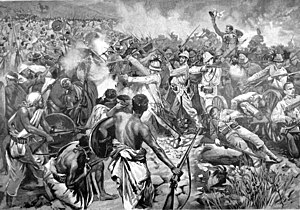
Back Slag van Adoea Afrikaans የአድዋ ጦርነት Amharic معركة عدوة Arabic آدوا دؤیوشو AZB Batalla d'Adwa Catalan Bitva u Adwy Czech Schlacht von Adua German Μάχη της Άντουα Greek Batalo de Adva Esperanto Batalla de Adua Spanish
| Battle of Adwa | |||||||
|---|---|---|---|---|---|---|---|
| Part of the First Italo-Ethiopian War | |||||||
 British illustration of "Dabormida's last rally" | |||||||
| |||||||
| Belligerents | |||||||
|
|
| ||||||
| Commanders and leaders | |||||||
|
|
| ||||||
| Strength | |||||||
| 73,000–100,000 | 14,519–17,770[1][2] | ||||||
| Casualties and losses | |||||||
| 3,886–7,000 killed |
~6,000 killed 3,865 captured | ||||||
Location within Ethiopia | |||||||
The Battle of Adwa (Amharic: የዐድዋ ጦርነት; Tigrinya: ውግእ ዓድዋ; Italian: battaglia di Adua, also spelled Adowa) was the climactic battle of the First Italo-Ethiopian War. Ethiopian army led by Ras Makonen Wolde Mikael managed to defeat the invading Italian force led by Oreste Baratieri on Sunday, March 1, 1896, near the town of Adwa. The decisive victory thwarted the campaign of the Kingdom of Italy to expand its colonial empire in the Horn of Africa.[3] By the end of the 19th century, European powers had carved up almost all of Africa after the Berlin Conference; only Ethiopia and Liberia still maintained their independence.[4] Adwa became a pre-eminent symbol of pan-Africanism and secured Ethiopian sovereignty until the Second Italo-Ethiopian War forty years later.[5]
- ^ Cite error: The named reference
Armies of the Adowa Campaignwas invoked but never defined (see the help page). - ^ Abdussamad H. Ahmad and Richard Pankhurst (1998). Adwa Victory Centenary Conference, 26 February – 2 March 1996. Addis Ababa University. pp. 158–62.
{{cite book}}: CS1 maint: location missing publisher (link) - ^ Woldeyes, Yirga Gelaw (29 February 2020). "The battle of Adwa: an Ethiopian victory that ran against the current of colonialism". The Conversation. Archived from the original on 4 June 2021. Retrieved 4 June 2021.
- ^ Cite error: The named reference
:0was invoked but never defined (see the help page). - ^ Cite error: The named reference
Abrahamwas invoked but never defined (see the help page).
